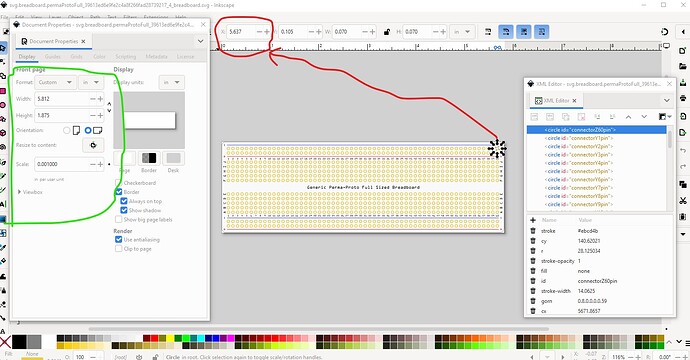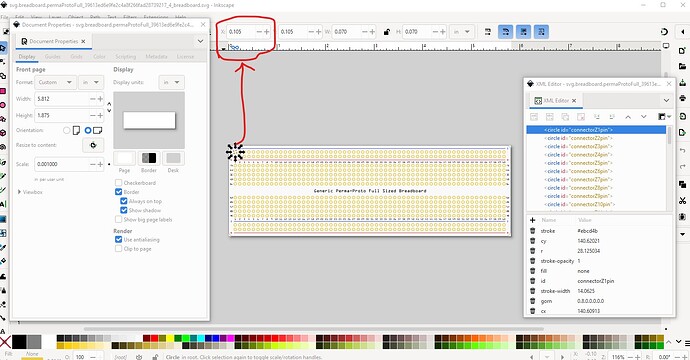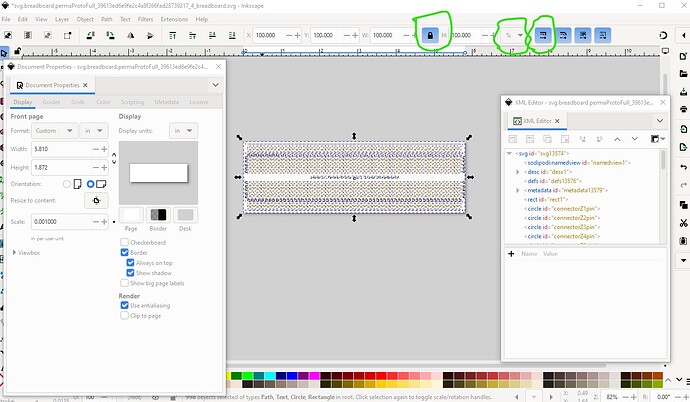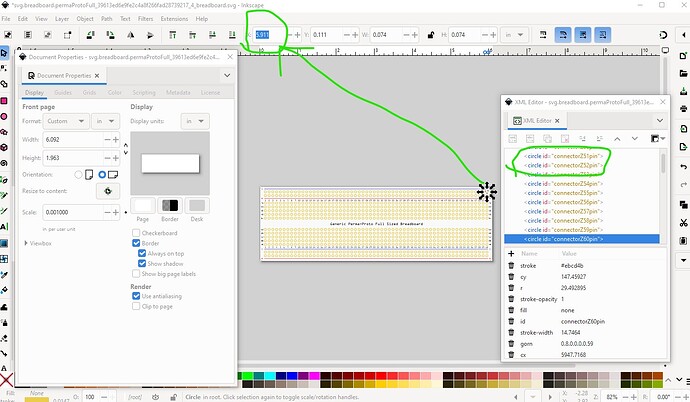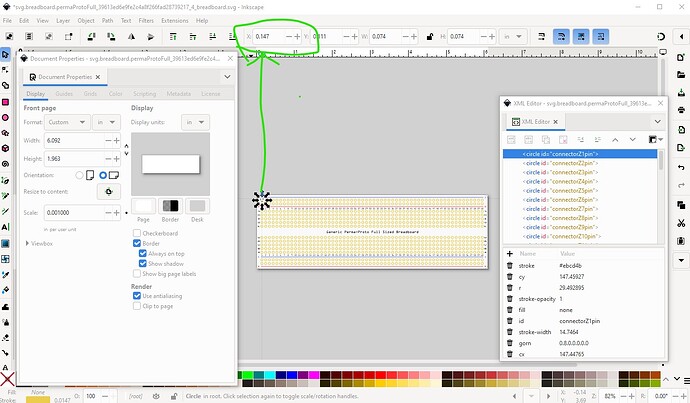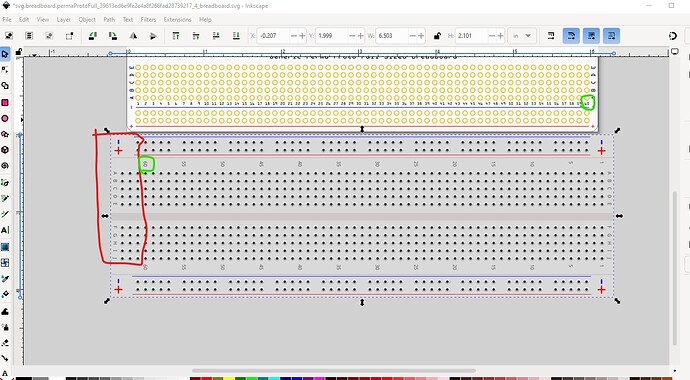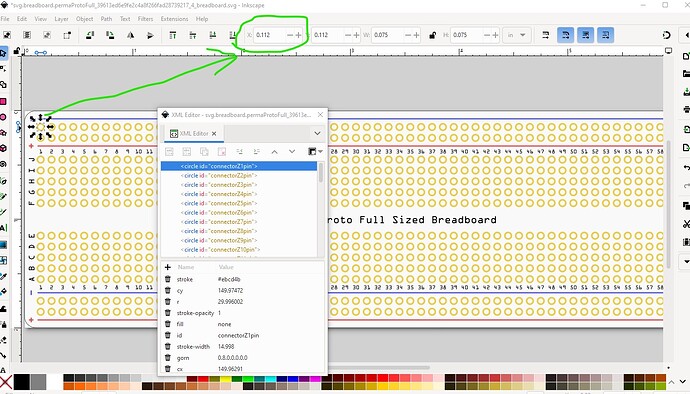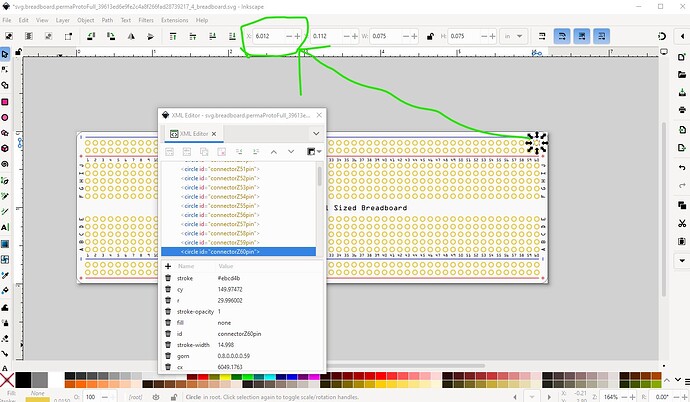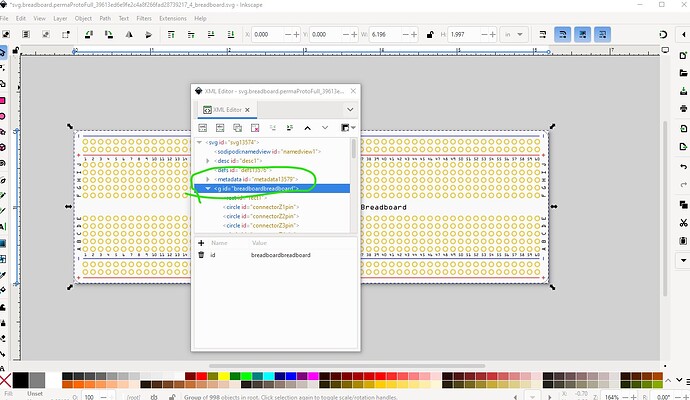Sure I can do them. Here is the first one and what I did to it (I suspect the others need the same treatment  .)
.)
PermaProto Full-rescaled.fzpz (23.8 KB)
The pins are not on 0.1in boundaries so find the x coord of the left most pin which is 5.672in subtract the x coord of the right most pin from that which is 0.141in to give the current length which is 5.531in. Compare that to a standard full breadboard (or count the pins which I am to lazy to do!) which is 6.134in - 0.335in = 5.8 in (which is actually high by 0.001in but close enough for goverment work!) So divide 5.8 by 5.531 = 1.048634966552161 and multiply it by 100 to get 104.8634966552161 which is how much we need to scale up by in %.
ungroup to remove transforms
the pins are not on 0.1in boundaries so find the x coord of the left most pin which is 5.672in subtract the x coord of the right most pin from that which is 0.141in to give the current length which is 5.531in. Compare that to a standard full breadboard (or count the pins which I am to lazy to do!) which is 6.134in - 0.335in = 1.048634966552161 (which is actually high by 0.001in but close enough for goverment work!) use 5.8in rather than 5.799in to correct for that. Then multiply it by 100 to get 104.8634966552161 which is the new scale we want.
so do an Edit->select all, then a Edit->resize page to selection to fix the viewbox at 0, 0 then lock horizintal to verical (to keep the circles circles) set the dimension to % and enable scale stroke-widths to set up the rescale. Then enter 104.8634966552161 to any toolbar coord window (all currently at 100) to do the rescale. Then do Edit->select all and Edit->resize page to selection to reset the viewbox correctly. Then check the pins are now on 0.1in boundaries. Looks like we may be too high. right x = 5.911in left = 0.111in. Ah! they are lying to me. Their board is not a full breadboard (which has 64 pins) it is only 60 pins
So I do have to do this by pin count. So close the modified svg without saveing and start again.
Odd I get different numbers this time. right most pin is 5.637in left most is 0.105in so length is 5.532in for 60 pins it wants to be 5.9in or a scale of 106.6522053506869% so try that and see what happens. The pins are now on 0.1in boundaries in both x and y (and all circles I hope!)
so group the svg and set the layerId to breadboardbreadboard (as this is now a breadboard in fact!)
So on to the .fzp file.
from
<module fritzingVersion="0.7.5b.07.02.6130" moduleId="permaProtoFull_39613ed6e9fe2c4a8f266fad28739217_4" referenceFile="Adafruit_Permaproto_Full_sized_Board__ae169a6a52289a88981faa0062203b34.fzp">
to
<module fritzingVersion="1.0.5" moduleId="permaProtoFull_39613ed6e9fe2c4a8f266fad28739217_4-ModuleID" referenceFile="Adafruit_Permaproto_Full_sized_Board__ae169a6a52289a88981faa0062203b34.fzp">
changing the Fritzing version and adding the breadboard prefix to the moduleId. The “-ModuleID” postfix trips the breadboard processing code on load.
from
<author>John De Cristofaro + JR</author>
to
<author>John De Cristofaro + JR (modified by vanepp June 2025)</author>
to admit I made changes.
from
<properties>
<property name="family">permaproto</property>
<property name="variant">generic</property>
<property name="size">full</property>
<property name="part number"></property>
</properties>
to
<properties>
<property name="family">Breadboard</property>
<property name="variant">generic</property>
<property name="size">Adafruit PermaProto Full</property>
<property name="part number"></property>
</properties>
change family to Breadboard (required to be a breadboard!)
and modify the size (as full is in use) to reflect the Adafruit part.
then do a global replace of layerId=“breadboard” to layerId=“breadboardbreadboard”
then do the same for the pins.
from
<p svgId="connectorW2pin" layer="breadboard"/>
to
<p svgId="connectorW2pin" layer="breadboardbreadboard"/>
to set the layerIds correctly. Then run the part through FritzingCheckPartw.py to verify it is good (lots of harmless errors FritzingCheckPartw.py doesn’t understand breadboards  ) I’ll do the other one tomorrow.
) I’ll do the other one tomorrow.
edit:
Here is the second one. Changes the same as the first (which probably need to be done on the rest too!)
Generic PermaProto Half-sized Board-fixed.fzpz (13.8 KB)
Peter
 ).
).